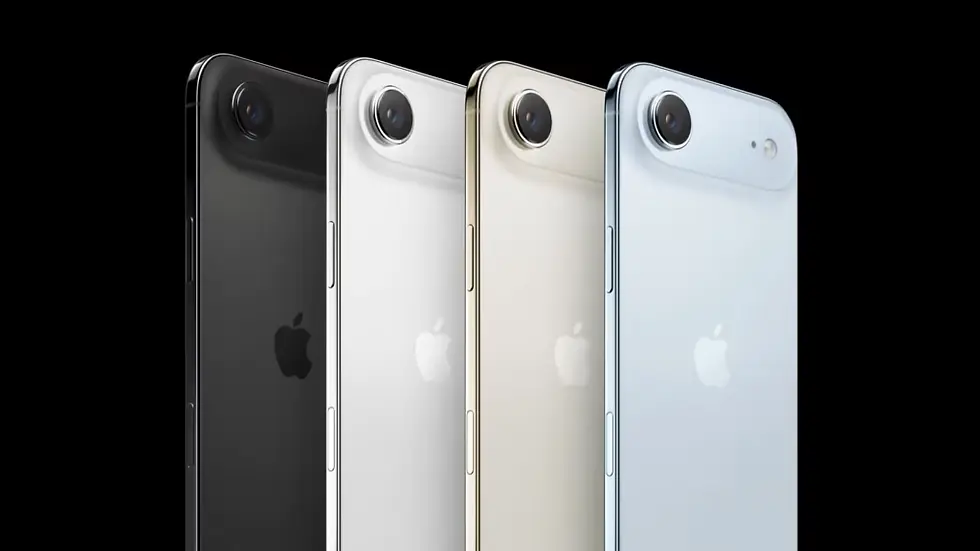Apple iPhone 17 Series Launch: Introducing iPhone Air, iPhone 17, and iPhone 17 Pro With Major Upgrades
- AndroBranch

- Sep 11, 2025
- 4 min read
Apple's long-awaited iPhone 17 series has finally rolled out, putting an end to months of rumors and leaks. Apple unveiled the new series at its lavish 'Awe Dropping' event this week, introducing aggressive design decisions, top-of-the-line performance, and innovative features. The centerpiece of this launch is the iPhone Air a completely new model that has taken the place of the previous Plus model joined by the regular iPhone 17 and the Pro line. Apple's approach appears to be straightforward: keep the simplicity in the central models and play big with the Air and Pro models.

iPhone Air
Among the new offerings, the iPhone Air makes headlines. Apple has launched it as an extremely thin and light option with flagship-class performance at a competitive price tag. Just 5.6mm thick, the iPhone Air is the thinnest iPhone to date, even thinner than the iPhone 6 (which was 6.9mm). At just 165 grams, it is also the lightest model in the series. With a strong titanium frame and Ceramic Shield back, Apple says the Air is tougher than any previous iPhone.
While the ultra-slender design is stunning, the main question is whether battery life or strength has been sacrificed in the pursuit of thinness. Apple promises that due to iOS 26's power-saving enhancements and MagSafe accessory capability, including the MagSafe battery pack, users can achieve up to 27 hours of video playback, expandable to 40 hours with an external battery. Real-world use will eventually determine the actual compromise between style and performance.
Extra Large 6.5-Inch ProMotion Display
The iPhone Air has a 6.5-inch screen size, which falls between the 6.3-inch iPhone 17 and the 6.9-inch iPhone 17 Pro Max. Even though the Air is thin, it doesn't compromise on visuals. It includes a ProMotion display with a 120Hz refresh rate, which provides silky-smooth scrolling and responsiveness in gaming, streaming, and day-to-day use. The large screen size makes it the perfect choice for those who want both portability and an immersive media experience.
New Camera Design and Features
In photography, the iPhone Air has a new rectangular camera bar with rounded edges. As opposed to Pro devices' dual-camera design, the Air features one 48MP Fusion rear camera with 2x optical zoom. There's the 18MP front Center Stage camera, which adapts framing using users' movements for better video calls and selfies. Dual capture and 4K video at 60fps are supported, coupled with the new Camera Control and Action Buttons.
Further, the Air supports USB-C connectivity, dual eSIM support (up to eight eSIM profiles), and does not include a SIM tray all in line with Apple's efforts towards eSIM adoption, even in India. MagSafe charging is also available for extra convenience.
Flagship Performance Powered by A19 Pro Chip
Performance continues to be a compelling selling feature of the iPhone Air. Driven by Apple's A19 Pro chip, the same as on Pro devices, it provides high-end performance for multitasking, heavy software, and gaming. This makes the Air a great option for those seeking flagship-level performance without the premium price of a Pro model.
With an initial price of ₹1,19,900 for the 256GB model, the iPhone Air comes in Space Black, Cloud White, Light Gold, and Sky Blue colors, with the storage options of 512GB and 1TB costing ₹1,39,900 and ₹1,59,900, respectively. It will go on sale in India from September 19th.
iPhone 17
The vanilla iPhone 17 brings comfortable upgrades, filling the performance affordability gap. Its most significant upgrade is the increased 6.3-inch screen size, now equal to that of the iPhone 17 Pro, and maintaining traditional looks with a dual vertical rear camera design in a pill-shaped hump.
For the first time, the standard model receives ProMotion technology with an adaptive 120Hz refresh rate, giving a more seamless experience. The display also comes to 3,000 nits peak brightness and features the highly sought-after Always-On Display, ensuring interaction is smooth. Protection is amplified through the Ceramic Shield 2, which has three times the scratch resistance of the last generation.
Bigger Battery and Camera Upgrades
Apple is keeping quiet regarding the actual battery capacities but asserts that the iPhone 17 has all-day battery life and eight more hours of video playback than the iPhone 16. There is also faster wired charging support.
Camera upgrades feature a dual 48MP Fusion primary and ultra-wide rear camera system with support for .5x, 1x, and 2x optical zoom. The 18MP Center Stage front camera, also shared by the Air, uses intelligent framing to create the most optimal video calls and selfies.
A19 Chip powers
The iPhone 17 also uses the same A19 chip used in the Air and Pro models, with a 16-core Neural Engine, six-core CPU, and 5-core GPU. Apple says its A19 chip delivers 20% improved performance over the last generation's A18-based iPhone 16 for a smoother and more efficient experience through apps, games, and multitasking.
The price for the iPhone 17 starts at ₹82,900 for the 256GB model and ₹1,02,900 for the 512GB model.
The iPhone 17 lineup doesn't break new ground but showcases Apple's strategic move of providing tidy but significant upgrades in the base model and experimenting with innovative looks with the iPhone Air. The Air is a slim, fast, and fashionable option at the cost of compromises such as one rear camera. In contrast, the iPhone 17 still incrementally gets better, so it remains a good option for users who value dependability and flagship performance at a moderate price.
Collectively, the iPhone 17 series is testament to Apple's changing vision: stretching design boundaries but remaining straightforward and easy to use. Indian buyers can look forward to these models appearing in stores from September 19th, potentially shifting the expectations of mid-premium smartphones.













Comments